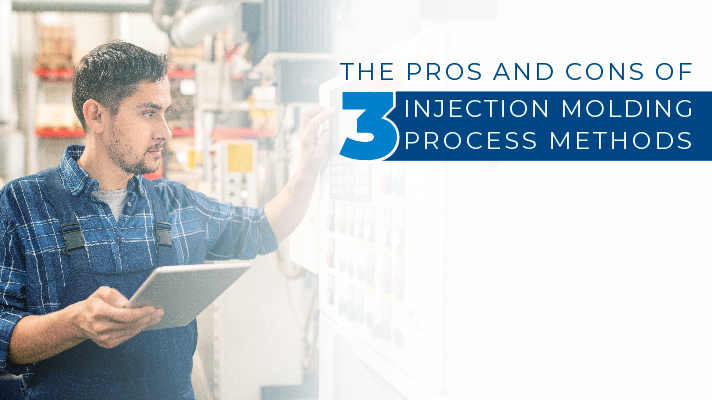
There are several ways to control your injection molding process, but which way is the best? The short answer is: whatever is right for your application. That’s why it’s important to understand each methodology so that you can make an educated decision as to which would work best for you.
Here is a breakdown and some pros and cons of the three main methods of injection molding processing: traditional injection molding processing, DECOUPLED MOLDING® II processing, and DECOUPLED MOLDING III processing.
Traditional Molding Process
Traditional injection molding processing uses pressure as the primary control and speed as the secondary control. The goal is to accomplish both fill and pack during the first stage, which means we control the process with injection pressure. As a result, traditional molding is typically a pressure limited process, and you are at the mercy of viscosity changes in the material.
As an example, if a molder wanted to fill faster, they would have to increase the injection pressure setting, but when the viscosity inevitably changes, flash or shorts may occur and they have to change the pressure again. This type of process requires a lot of attention and can produce a lot of scrap due to constantly having to make adjustments.
Pros: Very case-specific, simpler setup
Cons: Constantly adjusting for changes in viscosity, potential for higher scrap rates and run times, inconsistent part quality
DECOUPLED MOLDING II Process
In any DECOUPLED MOLDING process (whether II or III), there are two main principles: to have enough flow to achieve a desired flow rate, and to have pressure in abundance. We want to use speed as the primary control instead of pressure, which is the opposite of traditional molding.
In DECOUPLED MOLDING II (DII), we break down the process into two stages: fill and pack/hold. During the fill stage, we only focus on (you guessed it!) filling the mold using speed and velocity as the primary control. The goal is to fill the part as fast and as full as possible, consistent with quality.
The second stage focuses on packing and holding the part using pressure as the control. The goal of this stage is to finish filling the cavity, pressurize the cavity, and imprint the cavity wall’s surface onto the part.
By separating fill and pack through the use of transfer position, we begin to reduce the effect of viscosity variation that our material has on our process. This is a result of maintaining a repeatable, consistent flow rate during the first stage.
Pros: Improved cycle times, less scrap, no sensors or process control equipment required, process repeatability, consistent part quality
Cons: Training required in most cases
DECOUPLED MOLDING III Process
In DECOUPLED MOLDING III (DIII), we break down the process into three stages: fill, pack, and hold. The first stage, fill, is still controlled with speed/velocity. The goal is to have an 80-85%full part by the end of this first stage.
The goal of pack is to 100% fill and pack the part. DIII differs from DII, however, in that pack is also controlled by speed/velocity. We fill to a transfer position, then pack to a cavity pressure using a second velocity control. Once the cavity pressure set point is reached, we trigger the machine to apply hold pressure, taking us into stage three.
Stage three simply focuses on holding the part and ensuring the gate is sealed to eliminate any suck back or seepage from occurring.
Pros: Further improved cycle times, less scrap, flexible transfer controls for hard-to-control processes (i.e. thin wall, high tolerance applications), process repeatability, consistent part quality
Cons: Can be expensive initially (including training and equipment), some maintenance required
Conclusion
As you can see, there are benefits and setbacks for whatever injection molding processing method you choose, and it’s important to select the right one for your application. If you’d like help determining what would be best for you, feel free to reach out—we’re always here for you.
